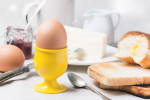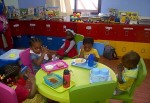Minor injuries are common in childhood – they are a normal part of children growing up, testing out new abilities and exploring the world. However, every hour, four children under the age of five are admitted to hospital with more serious accidental injuries. In 2010, 83 under-fives died following accidents.
The real safety risks
Child accident prevention is not about wrapping children up in cotton wool; it’s about protecting them from serious accidents – those which can hospitalise, disable or even kill. Some common accidents can have a lifelong impacton the child and their family, with falls from heights, burns and scalds, and road accidents all having the potential to cause disability and disfigurement.
Inequalities
There is a strong link between accidental injury and inequality: children from the most disadvantaged families are three timesmore likely to be admitted to hospital withserious accidental injuries and 13 times more likely to die in an accident.
Stages of development
Parents are often taken by surprise when their baby or toddler learns a new skill, such as grabbing, rolling over or crawling.Practitioners who work with parentsof young children can help to raise awareness of the biggest injury risks atdifferent stages of a child’s developmentand provide clear, practical and accuratesafety advice at each step.
Table 1: Key safety messages for parents at child development checks
| 1 – 6 weeks | 6 weeks – 6 months | 6 months – 1 year | 1 – 3 years | |
| Burns and Scalds | Hot drinks can scald in seconds – put yours down before picking up your baby |
Keep hot drinks, kettles and pans well away from curious hands
|
||
| Put hair straighteners in a safe place to cool | ||||
| Put cold water in the bath first | ||||
| Choking | Babies can choke if they’re propped up to feed – always hold them while feeding | Cut food into small pieces and keep small pieces like coins out of reach | ||
| Drowning | Use just 5cm of water at bathtime and never leave your baby alone in the bath | Supervise children near garden ponds and paddling pools | ||
| Falls | Take extra care when carrying your baby on stairs | Your baby could roll or wriggle off a raised surface – change nappies on the floor |
Protect your child from falls by:
|
|
| House fires | Test your smoke alarms regularly. Plan and practice a fire escape route. | |||
| Poisoning | Make sure tablets are kept out of reach. | |||
| Keep cleaning products locked away | ||||
| Road accidents | Use a car seat on every journey | Rear-facing child seats are safest -use one for as long as possible | Use a car seat that’s appropriate for your child’s weight, age and height. | |
| Encourage hand-holding or use walking reins/wrist straps when walking near traffic. | ||||
| Suffocation and strangulation | Babies can suffocate on duvets and pillows – save these until they’re over 1 year old | Tie up blind cords so they can’t cause strangulation | ||
| Keep nappy sacks in a safe place out of your baby’s reach | ||||
credit: unit- CPHVA in partnership with Mother care PLC, Early learning center and The child accident prevention trust.


